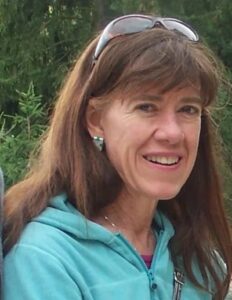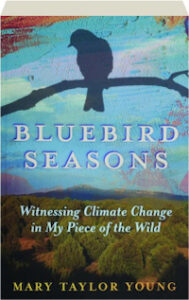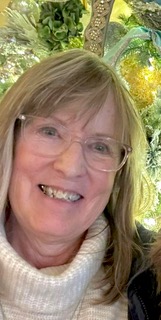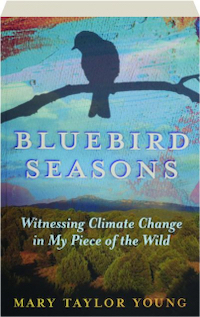‘Something is happening with the hummingbirds’
Bluebird Seasons observes climate change over 25 years in a small corner of Colorado
Bluebird Seasons observes climate change over 25 years in a small corner of Colorado
There’s a point in Bluebird Seasons: Witnessing Climate Change in My Piece of the Wild, where author Mary Taylor Young has a realization: what started as a lyrical nature memoir ended as a chronicle of climate change in real time.
The author and her husband live part of the year on 37 acres in the dry piñon and juniper foothills of the Sangre de Cristo Mountains southwest of Trinidad, Colorado. They bought their land in 1995, and as they began planning and eventually building a cabin for themselves, they also created a bluebird trail— a series of nesting boxes in bluebird habitat. The trail for the sky-colored members of the thrush family was one way they connected to their new environment.

Mary Taylor Young
One night, in June 2001, Young writes in her nature journal: “… as we sat on the deck listening to a poorwill calling from the dark, we heard a loud crack! crack!… We peered into the blue-black night, wondering what was out there, and what it was up to. In the morning, we discovered the answer.
“The American black bear.”
Young has a degree in zoology and has spent more than 30 years as a nature and wildlife writer. She is well-versed on bears’ superb olfactory abilities and their insatiable hunt for food. “I should have remembered that fact,” Young writes. Later that same summer, she experiences the reality of the predator who shares their land and who has helped itself to the contents of one of the bluebird boxes leaving only feathers and eggshell fragments on the ground.
Young, her husband and young daughter continue setting up nesting boxes, keeping in mind the cadence of nature.
“It’s the natural rhythm that all life on Earth is a part of, including us,” she writes, “in circles, that vary year to year but add up over many years to balance.”
That rhythm in the natural world forms the basis for Young’s book and that rhythm changes over time.
“And so, the simple story of ‘A Bluebird Season’ became Bluebird Seasons, a testament to a world that had altered, and was still altering,” Young writes.
Her graceful narrative of the ebb and tide of the land compels the reader through her book and makes the realities of climate  change palpable. She doesn’t dispute the natural food chain—a bear snacking on bluebird eggs and nestlings—but watches for changes in her ecosystem.
change palpable. She doesn’t dispute the natural food chain—a bear snacking on bluebird eggs and nestlings—but watches for changes in her ecosystem.
Writing about life unfolding on the family’s land provided the author with a 25-year-long digest of changes. Species’ habits changed. There were fewer and fewer elk on their land. Drought caused its own challenges—fewer wildflowers and grasses, a dried-up pond where frogs once lived. Piñon pines throughout the West were being wiped out by heat, wildfires, drought and insects, and as they disappeared, so did pinyon jays.
But when the smallest birds out of hundreds of species observed by Young changed their feeding habits, she took special notice.
Early in their time on their land, the family’s feeders were mobbed with boisterous broad-tail hummingbirds. The tiny birds generally arrive in Colorado in mid-April, but because the Young family bought their land in the fall, they didn’t see one until the following spring.
“June 1996: Hung a hummingbird feeder from the ponderosa near our campsite,” Young wrote in her journal. “Within an hour, a female broad-tail visited.”
By 2008, she had noticed a distinct change. “Something is happening with the hummingbirds,” she wrote. There were more black-chinned than broad-tails. By 2015, black-chinned greatly outnumbered the broad-tails; in May of that year, there wasn’t a single sign of a broad-tail.
The broad-tail was listed as a bird of highest vulnerability in the National Audubon Society’s 2019 “Survival by Degrees: 389 Bird Species on the Brink.” Young had witnessed that decline firsthand.
Young writes that she didn’t set out to become a witness to climate change, but she learned about it through her life in the foothills of southern Colorado.
“Our sightings are the rare data of climate change,” she writes. “The hundreds of entries about birds and nestlings, what flowers are blooming, the movements of bears and elk, the weather, reveal changes that are only evident over time.”
According to the Pew Research Center, “the perception that the effects of climate change are happening close to home is one factor that could drive public concern and calls for action on the issue.”
Young’s at-the-bird-feeder kind of evidence is easier to grasp than government studies and academic papers about climate change. It brings the subject of climate change and what it could mean directly to people’s backyards and their lives.
Young says she envisioned this book as a “lyrical nature memoir” and it succeeds on that level. Yet it is also a clear-eyed look at climate change in a way that allows people to understand what is at stake.
And with that, there is still hope. Young ends Bluebird Seasons with a passage from an Emily Dickinson poem: “Hope is the thing with feathers / That perches in the soul / And sings the tune without the words / And never stops at all.”
Deb Acord is a journalist and author from Woodland Park, Colorado. For decades, she wrote for The Colorado Springs Gazette, Rocky Mountain News, Denver Post and The Indy. At the Gazette, she was co-creator of Out There, a section devoted to the outdoors of Colorado. She is the author of Colorado Winter and Biking Colorado’s Front Range Superguide and has writtten car trend stories and environmental stories for Popular Mechanics.
Click here for more from Deb Acord.

